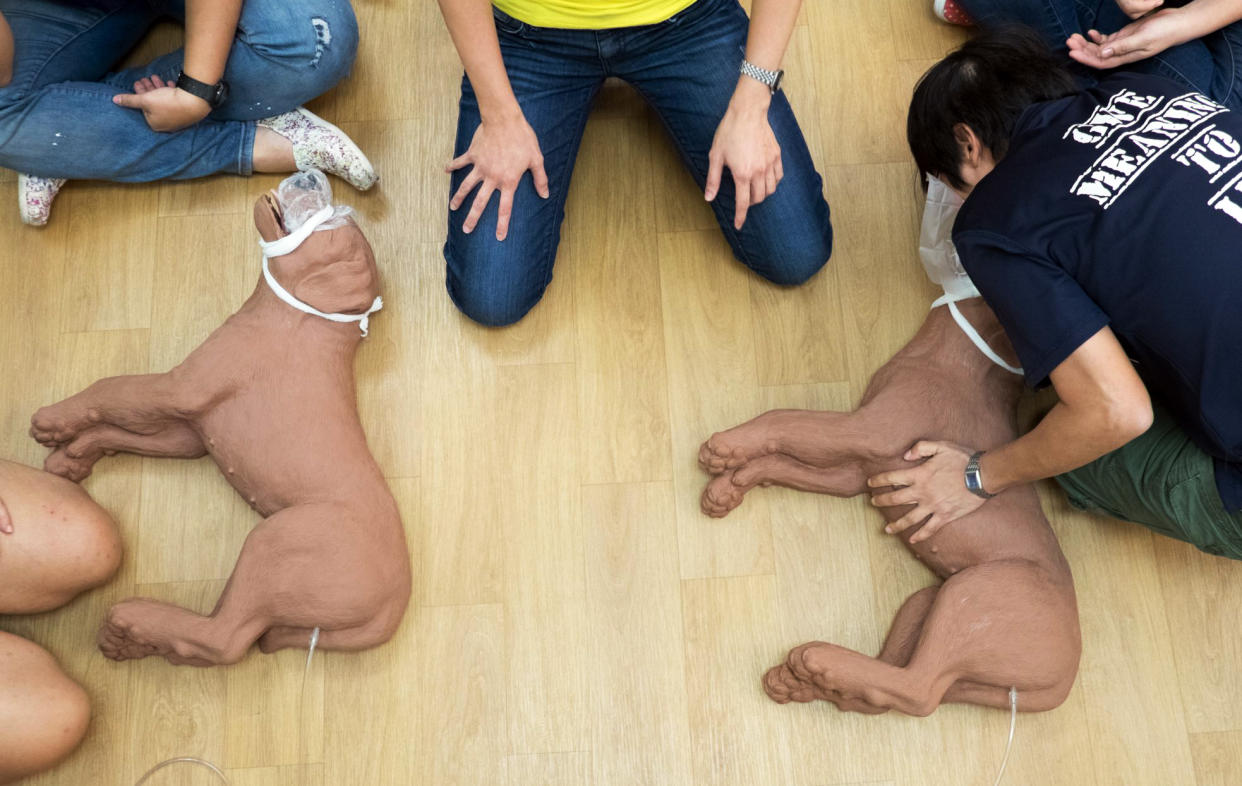When things get hairy: More people in Singapore learning first aid, CPR skills for pets

SINGAPORE — Maggie Charn was speaking with an owner of a miniature schnauzer in 2017 when the nine-and-a-half-year-old canine suddenly stopped breathing and fell unconscious.
Luckily for the owner, Charn knew how to administer cardiopulmonary resuscitation (CPR) on household pets such as dogs, cats, rabbits, and guinea pigs. She immediately applied her first aid skills to save Rocky, which had an existing heart condition.
“After about 10 to 12 times of chest compression, I heard a short cough followed by a very deep breath. He started to breathe and his heart was beating again,” said Charn, the owner of Dog First Aid, where she is a course instructor.
The 43-year-old is among an increasing number of people in Singapore who have learned CPR and basic first aid skills for pets. Courses here teaching such skills are also seeing an uptick in interest from the public.
For instance, at Dog First Aid, over 200 people were certified as Canine First Responders between 2015 and 2018, with about half the number coming from last year alone, said Charn.
About 100 people also completed Pawsitive Sensations’ PetSaver classes last year, said founder Zoe Gan, adding that she observed a surge in interest in the course over the past six months to a year.
The 40-year-old, who also conducts the Pet Tech-certified course on pet first aid skills, added, “With the increasing number of pet owners in Singapore, as well as Singaporeans, becoming more well informed about healthcare, it is natural that pet owners here would be more concerned about their own pet’s well-being.”
More than 800,000 pets in Singapore
There are an estimated 809,100 pets in Singapore in 2018 and the pet population is projected to grow to 820,000 this year, according to statistics from market research firm Euromonitor International.
Alongside Dog First Aid and PetSaver, a Basic First Aid for Pets course was also introduced at Ngee Ann Polytechnic (NP) last September and has taken on close to 30 participants so far.
An NP spokesperson said that the take-up rates for the school’s pet-related short courses have increased from last year. “This is encouraging and we will be launching more of such short courses in the latter half of this year,” said the spokesperson.
All three first-aid courses – often lasting about seven to nine hours over a single day – are typically capped to about 10 to 20 participants each.
Upon completion, participants would be skilled enough to handle life-and-death situations, such as pets choking on a toy or suffering from a cardiac arrest. They will also be able to conduct primary assessments; manage spinal injuries and choking; control bleeding wounds; and perform CPR on injured animals.
The classes offered by the three providers cost between $195 and $225, and are eligible under the SkillsFuture Credit scheme. They are conducted twice a month or once every two to three months, depending on the demand.
The bulk of the participants – ranging from those in their 20s to 70s – are pet owners, pet care professionals, and animal welfare volunteers, said Gan and Charn. A small number of them do not own pets but have encountered an emergency involving animals or are looking to own one in the future.
“I have had an 11-year-old participant accompanied by her mother and the oldest was a 79-year-old Caucasian man,” said Charn. “A lady who does not own any pets joined because of a personal encounter – she had accidentally knocked into a dog while driving in Malaysia and felt helpless.”
These participants can go on to volunteer their skills at various pet events, she added. For instance, about seven volunteer pet responders stood by at a recent event held at Gardens by the Bay, where 800 to 1,000 pet owners were expected to attend. Even before the event started, a dog had shown signs of heat stroke, said Charn.
Different strokes for different pets
While a handful of participants know how to perform basic first aid skills on humans, Dr Nicholas Haw, an instructor for NP’s basic first aid course for pets, pointed out that the techniques involved are very different.
As such, they may end up doing more harm if they were to apply the skills applicable for humans onto animals.
“Animals are different from humans, in terms of anatomy and body size,” he said. “Their heart and breathing rates are different, and the way to administer breaths is also different from humans.”
For instance, CPR for cats and dogs is done through their noses with their mouths closed. Instead of using palms, fingers are used to conduct chest compressions for smaller animals.
The chest compression rate for dogs is also twice faster than humans at about 100 to 120 per minute, said Dr Haw. The rate is slightly faster for cats compared with dogs, while it is four times faster for rabbits and guinea pigs compared with humans.
Lesser force should also be administered for chest compressions and giving rescue breaths to animals. “If the animal is very small and we blow into its nose, this may rupture its lungs,” he added.
Charn said, “When doing chest compressions for dogs or other animals, we lay them down on the side because their chests are narrow while humans have broad chests. But for animals with broader chests, it can be done the ‘human way’.”

Quick action to save lives
Interest in such courses is typically spread through word-of-mouth via social media and online hobby groups, said Gan.
More could be done by the authorities or animal rescue groups to educate the public on the importance of such skills, even as the pet industry in Singapore grapples with increasing regulations for pet shops and home boarding businesses, she added.
In comparison, owners are more aware of various aspects of pet care, such as nutrition and fostering better relationships with their pets, said Dr Haw.
“A lot of them bring their pets to vets – which is a good thing – but they are not aware that certain conditions or emergencies require first aid on the way to the clinic,” he added. Dr Haw cited an example of a motionless rabbit that was caught in a traffic jam while on the way to the clinic and it later died.
Celine Tan, 48, who runs canine boarding service Chubby’s Crib, said the skills she picked up during the course that she attended at NP are useful in her line of work.
“I know what to do when dogs experience heat strokes or when they need to be bandaged. Previously when I didn’t have these first aid skills, I would rush my dog to the vet, so now at least I know what to do prior to that,” added Tan, who herself owns a pet dog.
The rescue of Rocky the miniature schnauzer was the second time that Charn had applied CPR to save a pet’s life.
By then, she was familiar with the drill, having revived a dog in a similar fashion a few years earlier. She laughed, “But touch wood, hopefully, no more (of such incidents).”
Related stories:
Parliament: AVA to review rules governing pet boarding businesses
Need for tighter rules on pet cremation services following Platinium saga: AWOs


